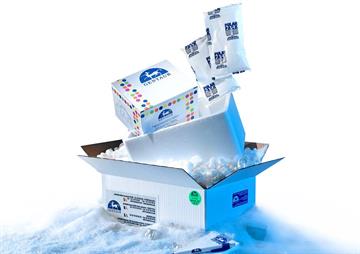APC Anti-Rat CD44H Antibody

APC Anti-Rat CD44H Antibody
382.05 EUR
In Stock
quantity
Produktdetaljer
Katalognummer: 965 - JOT22289F
Produktkategori: Företag och industri > Vetenskap och laboratorium
JotbodyGentaur
Storlek: 50Tests
Parameters
| Additional information | PBS with 0.05% Proclin300, 1% BSA |
|---|
Related Products
DL22289F-100Tests
APC Anti-Rat CD44H Antibody
CD44 is an 80-95 kD cell surface glycoprotein. It is expressed on all leukocytes, endothelial cells, hepatocytes, and mesenchymal cells. It is up-regulated when T cells and B cells are activated. It was reported that CD44 is a valuable marker for memory T cells. CD44 is an adhesion molecule involved in leukocyte adhesion and homing to lymphoid organs. The OX-49 antibody reacts with CD44H (known as CD44s) expressed on most leukocytes, except for a subset of B lymphocytes. The epitope recognized by OX-49 antibody has been mapped to a region on both the standard, CD44s, and the splice variant, CD44v, isoforms of CD44. However it was reported that OX-49 antibody cannot detect the CD44V isoform, possibly due to conformational changes in the epitope.
495 €
DL22289F-50Tests
APC Anti-Rat CD44H Antibody
CD44 is an 80-95 kD cell surface glycoprotein. It is expressed on all leukocytes, endothelial cells, hepatocytes, and mesenchymal cells. It is up-regulated when T cells and B cells are activated. It was reported that CD44 is a valuable marker for memory T cells. CD44 is an adhesion molecule involved in leukocyte adhesion and homing to lymphoid organs. The OX-49 antibody reacts with CD44H (known as CD44s) expressed on most leukocytes, except for a subset of B lymphocytes. The epitope recognized by OX-49 antibody has been mapped to a region on both the standard, CD44s, and the splice variant, CD44v, isoforms of CD44. However it was reported that OX-49 antibody cannot detect the CD44V isoform, possibly due to conformational changes in the epitope.
405 €
DL22294F-25ug
APC Anti-Rat CD44H Antibody
CD44 is an 80-95 kD cell surface glycoprotein. It is expressed on all leukocytes, endothelial cells, hepatocytes, and mesenchymal cells. It is up-regulated when T cells and B cells are activated. It was reported that CD44 is a valuable marker for memory T cells. CD44 is an adhesion molecule involved in leukocyte adhesion and homing to lymphoid organs. The OX-49 antibody reacts with CD44H (known as CD44s) expressed on most leukocytes, except for a subset of B lymphocytes. The epitope recognized by OX-49 antibody has been mapped to a region on both the standard, CD44s, and the splice variant, CD44v, isoforms of CD44. However it was reported that OX-49 antibody cannot detect the CD44V isoform, possibly due to conformational changes in the epitope.
450 €
DL22295F-25ug
PE/Cyanine5 Anti-Rat CD44H Antibody
CD44 is an 80-95 kD cell surface glycoprotein. It is expressed on all leukocytes, endothelial cells, hepatocytes, and mesenchymal cells. It is up-regulated when T cells and B cells are activated. It was reported that CD44 is a valuable marker for memory T cells. CD44 is an adhesion molecule involved in leukocyte adhesion and homing to lymphoid organs. The OX-49 antibody reacts with CD44H (known as CD44s) expressed on most leukocytes, except for a subset of B lymphocytes. The epitope recognized by OX-49 antibody has been mapped to a region on both the standard, CD44s, and the splice variant, CD44v, isoforms of CD44. However it was reported that OX-49 antibody cannot detect the CD44V isoform, possibly due to conformational changes in the epitope.
495 €
DL22295F-50ug
PE/Cyanine5 Anti-Rat CD44H Antibody
CD44 is an 80-95 kD cell surface glycoprotein. It is expressed on all leukocytes, endothelial cells, hepatocytes, and mesenchymal cells. It is up-regulated when T cells and B cells are activated. It was reported that CD44 is a valuable marker for memory T cells. CD44 is an adhesion molecule involved in leukocyte adhesion and homing to lymphoid organs. The OX-49 antibody reacts with CD44H (known as CD44s) expressed on most leukocytes, except for a subset of B lymphocytes. The epitope recognized by OX-49 antibody has been mapped to a region on both the standard, CD44s, and the splice variant, CD44v, isoforms of CD44. However it was reported that OX-49 antibody cannot detect the CD44V isoform, possibly due to conformational changes in the epitope.
686.25 €
DL22296F-25ug
PerCP/Cyanine5.5 Anti-Rat CD44H Antibody
CD44 is an 80-95 kD cell surface glycoprotein. It is expressed on all leukocytes, endothelial cells, hepatocytes, and mesenchymal cells. It is up-regulated when T cells and B cells are activated. It was reported that CD44 is a valuable marker for memory T cells. CD44 is an adhesion molecule involved in leukocyte adhesion and homing to lymphoid organs. The OX-49 antibody reacts with CD44H (known as CD44s) expressed on most leukocytes, except for a subset of B lymphocytes. The epitope recognized by OX-49 antibody has been mapped to a region on both the standard, CD44s, and the splice variant, CD44v, isoforms of CD44. However it was reported that OX-49 antibody cannot detect the CD44V isoform, possibly due to conformational changes in the epitope.
517.5 €
Håll dig uppdaterad! Visa tidigare publikationer

By: Author , 2 Comment
Pneumokocker – vad är det som angriper våra barn?
30 August 2025

By: Author , 2 Comment
Anaplasmos hos hundar och katter – allt du behöver veta
23 August 2025

By: Author , 2 Comment
Solbränna – hur leker man säkert i solen?
16 August 2025

By: Author , 2 Comment
Stroke – viktig information
8 August 2025








